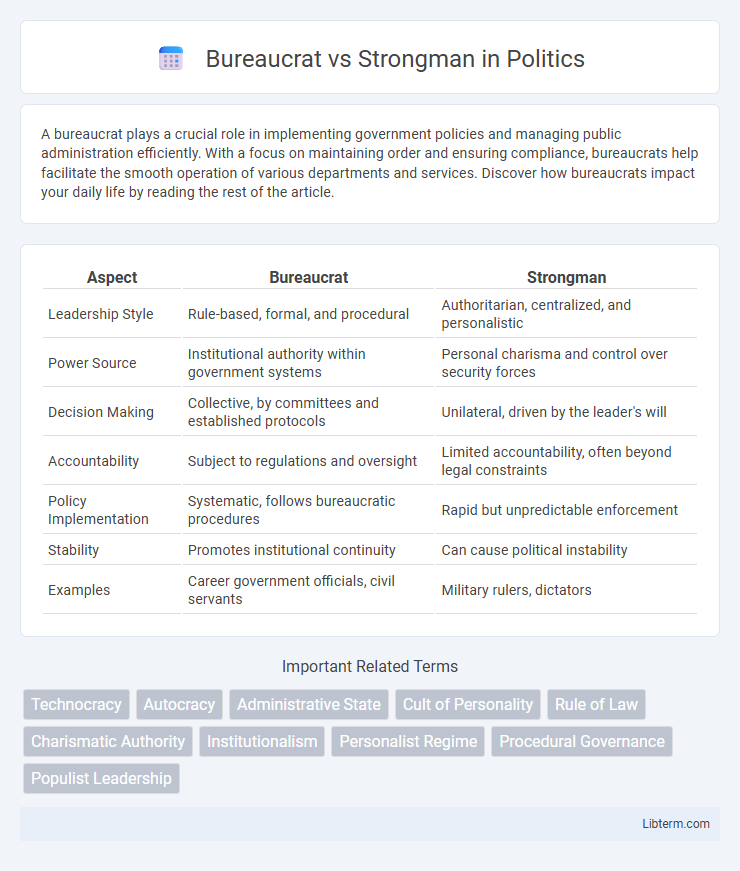A bureaucrat plays a crucial role in implementing government policies and managing public administration efficiently. With a focus on maintaining order and ensuring compliance, bureaucrats help facilitate the smooth operation of various departments and services. Discover how bureaucrats impact your daily life by reading the rest of the article.
Table of Comparison
| Aspect | Bureaucrat | Strongman |
|---|---|---|
| Leadership Style | Rule-based, formal, and procedural | Authoritarian, centralized, and personalistic |
| Power Source | Institutional authority within government systems | Personal charisma and control over security forces |
| Decision Making | Collective, by committees and established protocols | Unilateral, driven by the leader's will |
| Accountability | Subject to regulations and oversight | Limited accountability, often beyond legal constraints |
| Policy Implementation | Systematic, follows bureaucratic procedures | Rapid but unpredictable enforcement |
| Stability | Promotes institutional continuity | Can cause political instability |
| Examples | Career government officials, civil servants | Military rulers, dictators |
Introduction: Defining Bureaucrat and Strongman
A bureaucrat is a government official who operates within a structured administrative system, adhering to established rules, procedures, and policies to implement government functions efficiently. A strongman refers to a political leader who exercises centralized, often authoritarian control, relying on personal power and charisma rather than institutional frameworks. Differentiating these roles highlights the contrast between rule-bound governance and leadership driven by concentrated authority.
Historical Context of Bureaucracy and Strongman Leadership
Historical context reveals bureaucracy as a system rooted in rational-legal authority, emphasizing rule-based governance and administrative efficiency, prominent since Max Weber's analyses in the early 20th century. In contrast, strongman leadership often emerges in times of political instability, where power centralizes around a charismatic or authoritarian figure who bypasses institutional constraints. The evolution of modern states showcases bureaucracy's role in institutionalizing governance, while strongmen frequently disrupt or reshape these structures to consolidate personal power.
Key Characteristics of a Bureaucrat
A bureaucrat is characterized by adherence to formal rules, hierarchical authority, and a structured decision-making process, ensuring consistency and predictability within organizations. They prioritize procedural correctness, documentation, and impartiality to maintain organizational stability and accountability. Unlike strongmen who rely on personal power and charisma, bureaucrats emphasize institutional norms and rational-legal authority.
Key Traits of a Strongman Leader
A strongman leader typically exhibits traits such as centralized decision-making, authoritative control, and a reliance on charisma to maintain loyalty and power. This type of leader often bypasses institutional checks and balances, enforcing strict discipline and demonstrating a willingness to use force or intimidation to suppress opposition. Strongman leadership prioritizes stability and order, sometimes at the expense of democratic processes and legal norms.
Governance Styles: Rules vs. Authority
Bureaucrats govern through structured rules, procedures, and formal institutions that ensure consistency, transparency, and accountability within public administration. Strongmen rely primarily on personal authority, centralized power, and discretionary decision-making, often bypassing formal legal frameworks. Governance by bureaucrats emphasizes predictable policies and rule-based order, while strongman leadership centers on authority-driven control and rapid, top-down enforcement.
Decision-Making Processes Compared
Bureaucrats rely on structured decision-making processes with clear rules, protocols, and documentation, ensuring consistency and accountability within organizations. Strongmen prefer centralized decision-making, often bypassing formal procedures to make swift, unilateral choices driven by personal authority. This contrast impacts organizational flexibility, with bureaucrats favoring predictable outcomes and strongmen enabling rapid, adaptive actions in crises.
Public Perception and Popularity
Public perception of bureaucrats often centers on views of inefficiency and red tape, yet they are seen as essential for maintaining order and institutional stability. Strongmen tend to gain popularity through decisive leadership and charismatic authority, appealing to those seeking swift action and strong governance. However, their popularity can be volatile, frequently tied to economic performance and nationalistic rhetoric rather than sustained policy achievements.
Impact on Political Stability and Policy
Bureaucrats contribute to political stability by ensuring consistent policy implementation and adherence to legal frameworks, fostering institutional trust and long-term governance continuity. Strongmen often disrupt political stability through centralized power and authoritarian rule, which can lead to unpredictable policy shifts and undermine democratic institutions. While bureaucrats promote systematic policy development, strongmen emphasize swift decision-making, causing varying impacts on governance efficacy and public confidence.
Case Studies: Famous Bureaucrats and Strongmen
Famous bureaucrats like Max Weber exemplify the role of structured authority and rule-based governance in modern administrations, emphasizing rational-legal legitimacy. In contrast, strongmen such as Augusto Pinochet illustrate leadership based on personal authority and coercive power, often bypassing institutional norms to maintain control. Case studies reveal that bureaucratic governance fosters stability and predictability, while strongman rule tends to produce rapid, albeit often volatile, political change.
Future Trends: The Evolving Role of Leadership Styles
Bureaucrat leadership, characterized by structured procedures and rule adherence, faces challenges adapting to rapidly changing global environments, while strongman leadership, marked by centralized authority and decisive action, may struggle with increasing demands for transparency and accountability. Future trends indicate a hybrid approach blending bureaucratic stability with the agility of strongman decision-making, leveraging technology and data-driven insights to optimize governance. Emerging leadership models emphasize emotional intelligence and adaptability, preparing leaders to navigate complex socio-political landscapes beyond traditional bureaucratic rigidity or authoritarian control.
Bureaucrat Infographic

 libterm.com
libterm.com